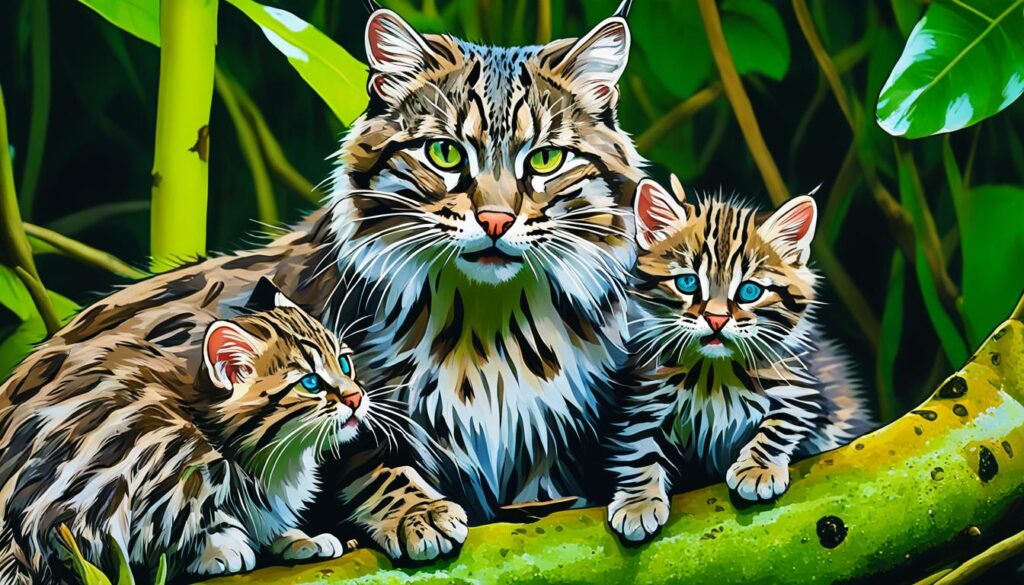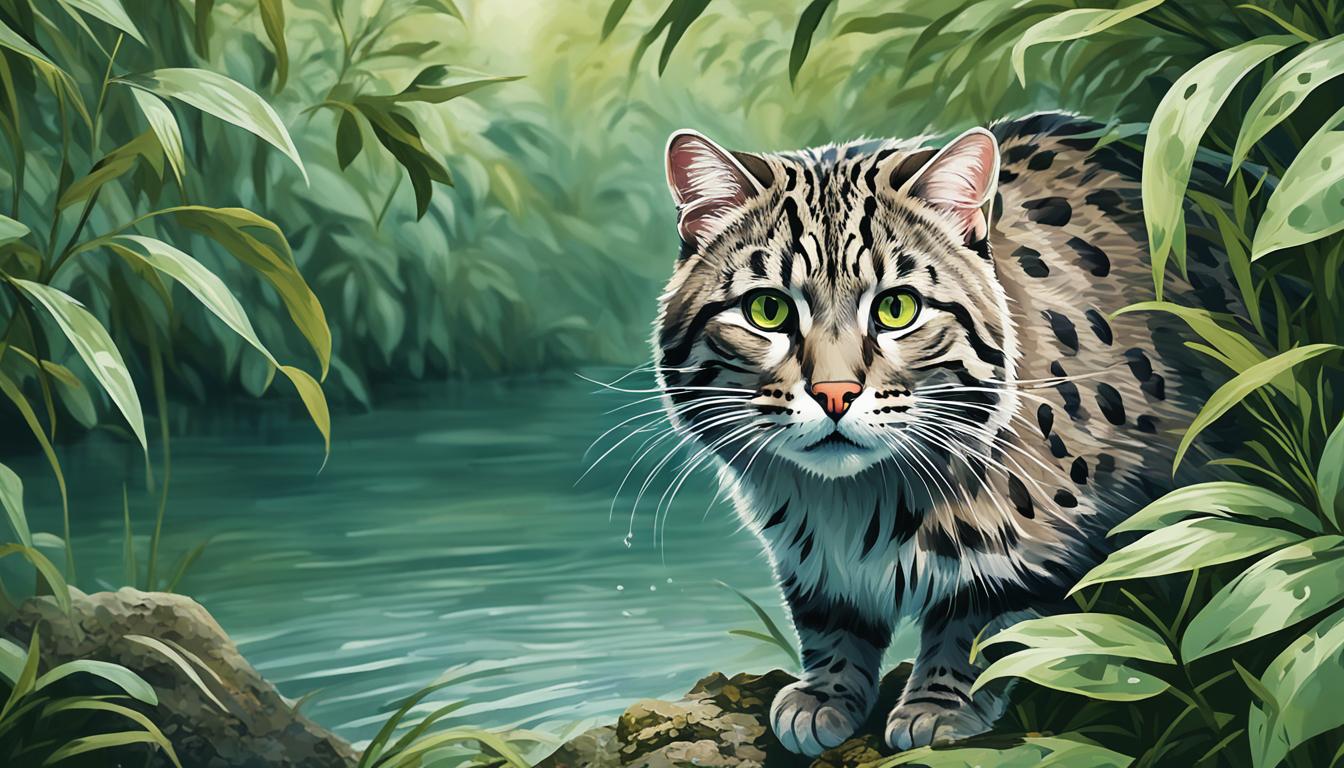This post contains affiliate links.
Imagine standing by the water as evening falls, surrounded by cricket songs. Your gaze follows the water’s ripples when a sleek animal appears. It’s the fishing cat, an endangered species, battling for survival. These cats are not just animals; they’re a conservation challenge. This guide will take you into the world of fishing cats, the dangers they face, and their precious homes.
As you dive deeper, you’ll learn about their webbed feet and why saving them matters. This journey will change how you see the fishing cat. They’re not just part of nature’s design but a key piece that we must protect.
Key Takeaways
- Discover the unique adaptations that enable the fishing cat to thrive in aquatic environments and ensure their conservation.
- Understand the fishing cat’s nocturnal behavior and how these endangered species navigate the moonlit realm of their wetland habitat.
- Explore the threats that put the fishing cat population at risk, including habitat destruction and other human-induced perils.
- Learn about the diet and specialized “fishing” techniques that define the behavior of these remarkable predatory felines.
- Uncover actionable ways you can contribute to fishing cat conservation efforts and help protect their diverse habitats.
Understanding the Fishing Cat’s Wetland Realm
Dive into the world of fishing cat wetland habitats. These unique areas are home to amazing cats with special water skills. Learn about their endangered homes and the work to save them.
Wetland Destruction: A Threat to the Fishing Cat
Fishing cats are losing their homes due to wetland destruction. This loss harms many creatures relying on this environment. Scat shows their shrinking territories, affected by human expansion and deforestation1.
Fishing cats, marked as ‘vulnerable’, face losing their home1. They are wrongly seen as pests. In West Bengal, they’re confused with tiger cubs and killed on roads1.
Adaptations for an Aquatic Life
Fishing cats excel underwater thanks to their abilities. Their size and webbed paws make them skilled swimners and hunters1.
These cats maintain their territory, like in the Coringa Wildlife Sanctuary1. Here, 115 were found in 2019. Their survival shows the efforts to raise awareness and stop poaching1.
| Threat | Impact on Fishing Cat Population | Conservation Actions |
|---|---|---|
| Wetland Destruction | Habitat loss; mistaken identity leading to roadkills in West Bengal1 | Education, awareness, legal protection |
| Aquatic Adaptations | Decline due to shrinking territories | Monitoring populations, habitat restoration |
| Conservation Efforts | Stabilization of populations in certain areas like Coringa Wildlife Sanctuary1 | Active forest departments, community involvement |
Thinking about this, imagine a world without the fishing cat’s purr. We can change the fate of their wetland destruction and habitat loss. Your actions can help save these beautiful cats.
The Physical Traits of Fishing Cats

Have you ever wondered what makes fishing cats great at catching fish? Let’s look at the physical traits that make these cats special. Even though they are not as big as house cats, they are very strong. They weigh between 11 to 35 pounds and are excellent swimmers because of their strong bodies.
Their fur is another amazing feature. It ranges from gray to olive green, with spots and stripes. These fur color variations and markings help them hide in their wetland homes. Besides their fur, they have more features of fishing cats that are like nature’s masterpieces.
Their heads are wider than other cats, and they have strong jaws. This helps them eat fish. Plus, if you look at their paws, you’ll see they are partly webbed. This helps them swim well. Watching a fishing cat, you can see these natural wonders in action.
But there’s a sad side to their story, too. Fishing cats in Bangladesh are losing their lives due to human conflict. More than half of these conflicts end badly for the cats2. By learning about their physical strengths and problems, we become more connected and motivated to help them.
Decoding the Behavior of Fishing Cats
Have you ever been curious about fishing cats? These creatures are unique in the cat world. They hunt at night and have amazing skills. Unlike other cats, they love water and use it to catch food.
“Fishing” Techniques and Dietary Preferences
Fishing cats catch their food in a cool way. They use their paws to trick fish into coming closer. This trick works because it looks like insects on the water’s surface. They eat fish and other animals from wetlands.
Nighttime Hunters: The Moonlit Domain
When night falls, fishing cats start their hunt. They move silently in the moonlight, watching for prey in the water. Shadows and reflections help them see fish moving.
Now, let’s talk about your pet cat at home. Did you know they share traits with fishing cats? Toys you play with them mimic the fishing cat’s hunting. It keeps them busy and happy3. Your cat also needs a safe place to hide and rest, just like fishing cats do4.
Playing with your cat is important for their health. Try playing in short sessions each day to keep them active3. It’s like they’re little hunters watching birds or cat videos. And don’t forget about older cats. A litter tray that’s easy to use will help them stay comfortable4.
Fishing Cat
Curious about the fishing cat? These creatures are not your ordinary cats. They love wetlands and river environments, showing how nature can adapt. These cats are ‘vulnerable’, living in northern and eastern India and the mangroves of the east coast. They thrive in areas most animals avoid156.

In West Bengal, the fishing cat habitat is under threat. Some fishing cats die in accidents or from poaching1. West Bengal made the fishing cat its state animal in 2012. This helps raise awareness for these amazing cats1. Andhra Pradesh is also taking action to protect them from poachers1.
As night falls, fishing cat behavior becomes interesting. They hunt, often surprising birds5. Their hunting was observed over 282 nights. It showed their role in the ecosystem5. Despite conflicts with humans, these cats keep living strong5.
Fishing cats have families too. Females give birth to two or three kittens. These kittens will grow up to be hunters like their ancestors5. Conservation efforts are crucial to protect these animals. The Fishing Cat Conservancy monitors their numbers closely15.
In Nepal, about 70% of fishing cats live outside protected areas6. This makes them vulnerable to dangers like snares. Pollution and pesticide use also threaten them6. Conservationists work hard to save them, knowing how important they are to our world56.
When you hear “fishing cat facts”, think about their struggles and strength. They need our help to survive. Fishing cats show us that the night is full of life. We share this planet, and it’s up to us to take care of it together56.
Habitats Across the Globe: Where Do Fishing Cats Thrive?
Fishing cats move quietly through wetlands and forests across mainland Asia. They live in places like India and Sri Lanka, moving through Nepal, Bangladesh, and other countries. These cats love to stay near streams, dive into rivers, and live in areas from the Himalayan foothills to mangroves7.
The story of the fishing cat’s home is about their fight to survive. With maybe just 3,000 left in the wild, their fight is urgent. Their diet is mostly fish, showing their deep bond with the water ecosystems now in danger7.
The Dense Forests and Stream Networks
Picture the perfect place for a fishing cat: forests and streams everywhere. This is where they hunt and live. Yet, this reality is threatened, with over 45 percent of protected and 94 percent of significant wetlands in Southeast Asia at risk7.
Altitudinal Range: From Plains to Mountainous Realms
Fishing cats are found from flat lands to mountain edges. They adjust to various heights with ease. Their ability to thrive here shows their strength, even as development and shrimp farms threaten their homes8.
| Region | Threat Level | Population Impact |
|---|---|---|
| Mainland Asia & Islands | High | Population in decline due to habitat loss7 |
| Urban Areas (e.g., Colombo) | Medium | Species exhibits adaptability to urbanized landscapes7 |
| Mountainous Regions | Medium | Existence uncertain due to lack of studies8 |
| Wetlands (Thailand) | Critical | Decimation by shrimp farming and aquaculture8 |
So, this is the fishing cat’s world. Where they live tells a story of survival and challenges they face. When you enjoy shrimp, think about the fishing cat whose home was affected8.
Reproduction and Lifecycle of Fishing Cats
Welcome to the enchanting realm of fishing cat reproduction and lifecycle. Here, the secrets of their mating behavior and their gestation period unveil nature’s resilience. Did you know these stunning creatures have a lifecycle that fascinates many? Let’s explore it together.

Reproducing is crucial for these cats, some of which are vulnerable or endangered. Fishing cats mature sexually by 15 months. They can live up to 10 wonderful years in captivity9. Their wild relatives follow a similar path, maturing based on their size. Smaller ones like fishing cats grow up in 1 to 2 years. Larger species take 3 to 4 years to reach maturity10.
| Aspect | Description |
|---|---|
| Mating Behavior | Fishing cats have a dynamic courtship. It varies with reproductive seasonality and ovulation, influenced by genes and environment10. |
| Gestation Period | A fishing cat’s pregnancy lasts 63 to 70 days. Then, they welcome their kittens into the world9. |
| Litter Size | Most litters bring two or three kittens. Each one is a vital addition to their species9. |
| Maturation Variability | Environment and lineage impact when they mature. Over half of felid species show varied hormones patterns10. |
Fishing cats are sensitive to the changing seasons. They adapt their breeding methods to nature’s rhythms. Females can breed year-round under certain lighting indoors. This insight supports conservation efforts10. Seasonal changes also influence reproduction in wild cats. They ensure offspring are born under optimal conditions10.
In zoos, connections exist between fecal glucocorticoids and environmental elements like rain and daylight. There’s a positive correlation with rain, and a negative one with daylight. It’s as though they’re in sync with the earth’s pulse, even in captivity9.
Several factors impact this chapter of their lives. This ranges from their quiet courtship to caring for their young. Despite their size, their passion for the circle of life is immense. You’re observing resilience at its finest – the enduring story of the fishing cat lifecycle.
Rare Interactions: Fishing Cat Encounters with Humans
Picture yourself on the bustling streets of Colombo, seeing a fishing cat. This creature is one of the rare ten spotted in this lively city1. These fishing cat interactions with humans are growing as cities expand. Nearly 10 percent of the Earth’s land is expected to become urban by 20301. Over half of us now live in cities, making it crucial to find ways to live together with nature1
Conflict and Coexistence
As natural spaces shrink, conflicts between humans and wildlife, like the fishing cat, happen more often. A landlord lost most of his koi fish to a fishing cat named Mizuchi1. This cat roams over two square miles. In these conflicts, people and animals are finding ways to live in peace, respecting each other’s needs.
The Role in Folklore and Human Culture
Fishing cats hold a special place in folklore, affecting how communities see them. They often appear as magical beings in stories, respected for their mysterious and solitary ways. These cats are more than animals; they symbolize local traditions and a deep respect for nature.
| Element | Fishing Cats Interaction | Community Cat Dynamics |
|---|---|---|
| Interaction with Humans | A combination of curiosity and necessity drives the infrequent but impactful encounters. | Community cats exhibit a broad behavioral spectrum, from the socialized tame to the independent feral2 |
| Human-Wildlife Dynamics | Urban expansion intensifies encounters, often leading to conflicts over territory and resources. | A range of factors including food availability and human caretaking level influence interactions2 |
| Social Structure | Solitary by nature, their territory may overlap with human domains k>1 | Cat colonies form through social bonds and frequent interactions among individuals2 |
| Cultural Embedment | Embedded in folklore, they are both respected and feared, seen as guardians and competitors. | Cats are integral to community life, with roles ranging from pest control to companionship2 |
As you explore areas where these felines live, keep in mind their story with us. It’s not just about conflict but also about mutual understanding and cultural connection. Their survival amidst urban growth shows nature’s resilience and highlights our shared duty to protect our planet1k>2
Conservation Status: The Perils Facing Fishing Cats
While you catch up with the latest gadgets, fishing cats are facing tough times. They are listed as “vulnerable” on the IUCN Red List11. These cats face a range of threats that put their future at risk. For instance, their numbers have dropped by over 30% in the past 15 years12. They’ve even vanished from Java in Indonesia12. These numbers are a wake-up call for fishing cat conservation efforts.
In places like Sri Lanka, fishing cats are trying to fit into city life12. However, growing cities bring problems, like more conflicts with people11. Imagine a mother fishing cat, who might have two to three kittens, facing dangers even from bird colonies at night11. It’s a hard fight for these cats to survive.
Yet, there’s hope with projects like the Project Fishing Cat in Bangladesh12. It focuses on the Hail haor region, where these cats are often found. At the same time, scientists are tackling health issues. They study a kind of cancer that caused 13% of deaths in fishing cats at zoos over nine years13. By looking at their genes, they hope to protect these cats from diseases they inherit13.
“In the labyrinth of conservation, every step we take echoes in the ripples of fishing cat survival.”
Seeing the dangers to fishing cats makes you a possible helper12. If their situation touches you, your voice matters in conservation talks. Starting with being aware can lead to change. Let’s work to keep these cats in our world, not just in old tales.
How You Can Help Protect these Endangered Felines
The world has seen almost 90% of its wetlands disappear since the 1700s14. This loss puts animals like the fishing cat in danger. They depend on these areas to live and thrive14. Fishing cats, found in South and Southeast Asia, face risks mainly because of human actions14. You can help by supporting conservation efforts. Small steps matter. They include choosing responsible travel options and getting behind conservation projects.
Supporting Conservation Efforts
Did you know? Experts are using smart ways to save these cats, like planting a special type of rice to protect their homes14. You can help in many ways:
- Donate: Your donations support vital research and habitat rebuilding efforts.
- Volunteer: Your time can make a difference. Help groups focused on saving wetlands.
- Education: Know the challenges fishing cats face. Spread awareness about their situation and why we need to save wetlands.
Responsible Tourism: A Path to Coexistence
It may seem tough, but responsible tourism can help us live in peace with fishing cats. When you visit their home areas, which stretch from Pakistan to Vietnam, you can have a positive effect14. Choosing eco-friendly travel options and respecting the wildlife makes you more than just a visitor. You become a champion for their cause.
| Challenge | Conservation Action | How You Can Help |
|---|---|---|
| Intensive Aquaculture | Commercialize sustainable practices | Choose seafood with eco-certifications |
| Pollution | Push for stricter regulations | Participate in clean-up drives |
| Upriver Damming | Engage in dialogues for river conservation | Advocate for renewable energy alternatives |
Seafood lovers, remember this14. The fishing cat loves fish, especially catfish. Choosing sustainably-fished seafood means you’re helping these special cats live better lives.
Conclusion
In this journey, we’ve seen that the fishing cat’s survival leans on our dedication and united effort. In Nepal, a glimpse of hope exists within 6679 km2 of suitable habitats. These areas host life along the beautiful wetlands and rivers15. Yet, many of these habitats aren’t protected, putting these cats at risk of fading away15. The guide’s summary shows their survival is a sign of nature’s strength and our actions.
From 2009 to 2020, there were 312 sightings of fishing cats in Nepal’s Terai region. This area is not only rich in wildlife but also vital to local culture. Yet, it faces pressure from human development15. In Thailand, conservationists are using advanced science to help save them, as the IUCN Red List shows they’re at risk16. They are turning to genetics to offer hope for the fishing cats’ future16.
These discoveries make us face a choice: knowing is one thing, but acting makes the difference. This marks not an end, but a beginning to help. It calls us to protect their homes, understand our shared traditions, and support this species. It’s up to us, the future’s caretakers, to make sure these cats not only survive but thrive1516.
FAQ
What is a fishing cat?
Why are fishing cats endangered?
Where do fishing cats live?
How do fishing cats fish?
What do fishing cats eat?
Are fishing cats nocturnal?
How can I help protect fishing cats?
Are fishing cats dangerous to humans?
Can fishing cats be kept as pets?
What is the conservation status of fishing cats?
Do fishing cats have any predators?
Source Links
- https://www.thehindubusinessline.com/blink/explore/fishing-cats-the-remarkably-patient-animals-that-are-now-vulnerable/article31647652.ece
- https://news.mongabay.com/2024/04/navigating-the-rise-in-conflicts-between-humans-and-fishing-cats-in-bangladesh/
- https://www.psychologytoday.com/us/blog/decoding-your-pet/201503/kitty-play-saves-the-day
- http://shine.waltham.com/cats/environment
- https://earth.com/news/why-are-fishing-cats-raiding-bird-nests-in-the-treetops/
- https://news.mongabay.com/2023/08/more-research-leads-to-more-awareness-qa-with-fishing-cat-expert-rama-mishra/
- https://news.mongabay.com/2016/08/out-of-sight-out-of-mind-asias-elusive-fishing-cat-in-trouble/
- https://www.biographic.com/fishing-cats-cradle/
- https://www.ncbi.nlm.nih.gov/pmc/articles/PMC4892097/
- https://clinicaltheriogenology.net/index.php/CT/article/download/9327/15218
- https://www.earth.com/news/why-are-fishing-cats-raiding-bird-nests-in-the-treetops/
- https://www.thedailystar.net/opinion/views/news/our-efforts-can-save-the-fishing-cat-extinction-3395696
- https://www.nature.com/articles/s41598-024-56003-7
- https://www.smithsonianmag.com/science-nature/fishing-cats-face-human-threats-save-them-180981010/
- https://www.ncbi.nlm.nih.gov/pmc/articles/PMC9034449/
- https://www.frontiersin.org/articles/10.3389/fvets.2022.989670
This post contains affiliate links.

